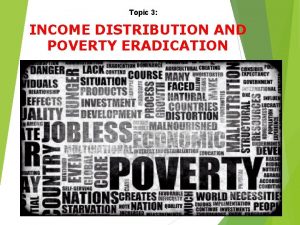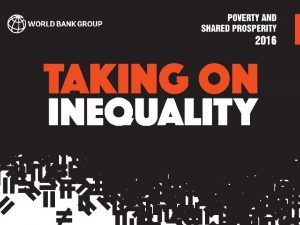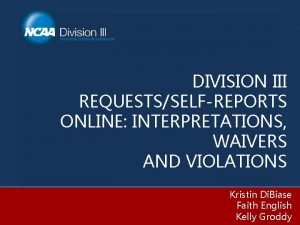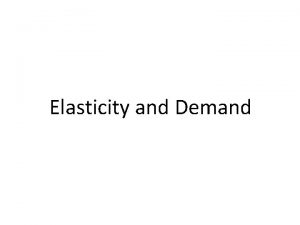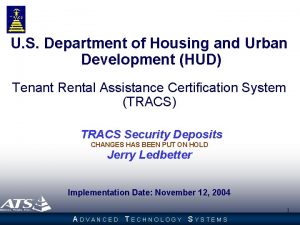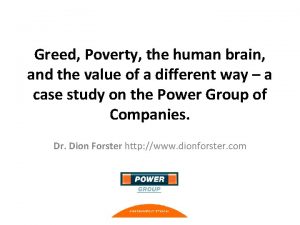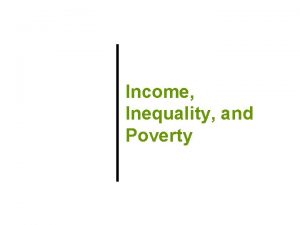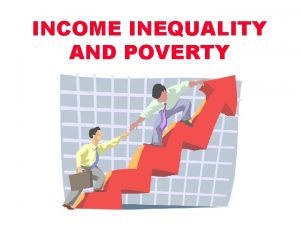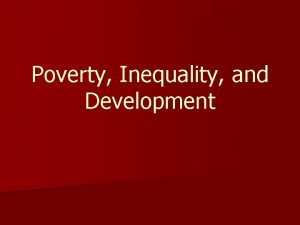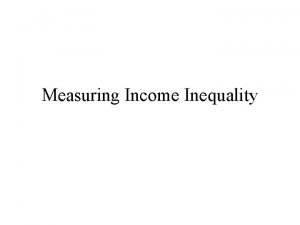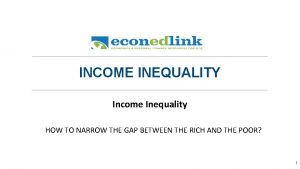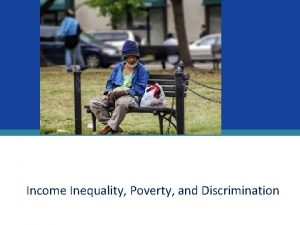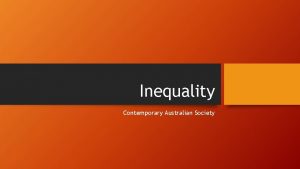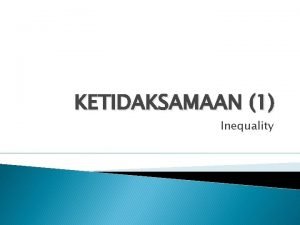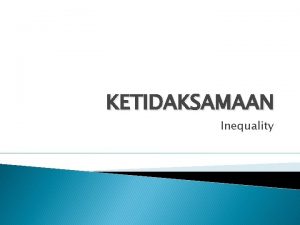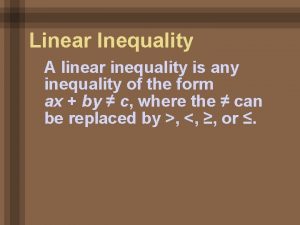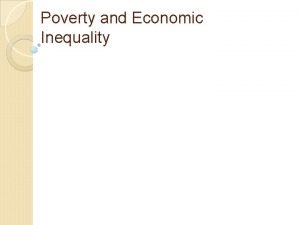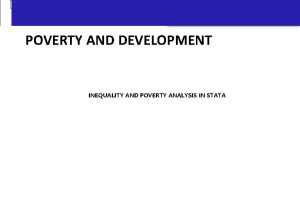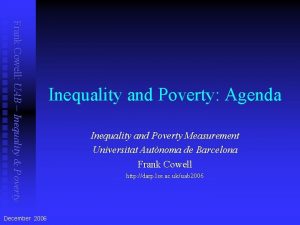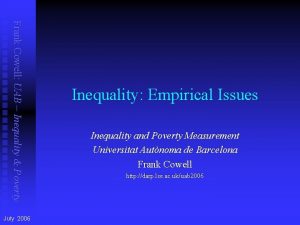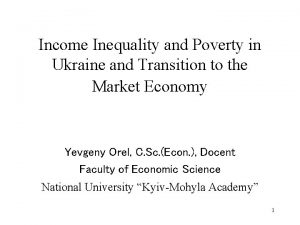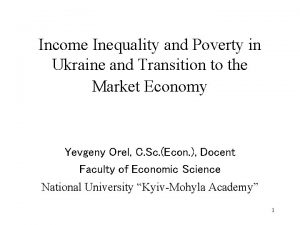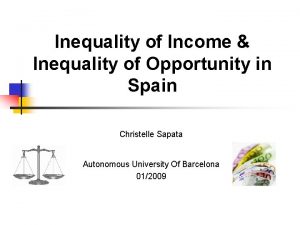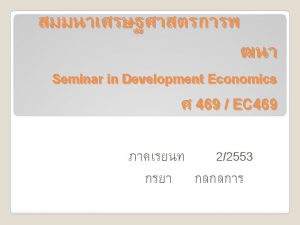15 Income Inequality and Poverty Previously The demand






















































- Slides: 54

15 Income, Inequality, and Poverty

Previously • The demand for each factor of production is a derived demand that stems from a firm’s desire to supply a good in another market. • Labor markets reconcile the forces of demand supply into a wage signal that conveys information to both sides of the market. • A monopsonist in the labor market is able to leverage market power by paying workers less. • In the long run, outsourcing moves jobs to workers who are more productive, and thus increases the overall productivity of workers everywhere.

Big Questions 1. What are the determinants of wages? 2. What causes income inequality? 3. How do economists analyze poverty?

What are the Determinants of Wages? • Nonmonetary determinants of wages • Wage discrimination • Winner take all

The Nonmonetary Determinants of Wages— 1 • Compensating Differentials – The difference in wages offered to offset the desirability or undesirability of a job. • Education and Human Capital – Human capital is the skills acquired through education and training.

Education and Pay

The Nonmonetary Determinants of Wages— 2 • Location and Lifestyle – Would you rather live in Florida or North Dakota? – Why would wages in NYC be higher than in Omaha, Nebraska? – Why would you be willing to accept relatively low pay to work for the Peace Corps?

The Nonmonetary Determinants of Wages— 3 • Union – A group of workers that bargains collectively for better wages and benefits. – Able to increase wages by threat of a strike, or work stoppage.

The Nonmonetary Determinants of Wages— 4 • Union – For unions that cannot strike (teachers, police) binding arbitration may resolve wage disputes. – Over time the number of unionized workers and the union wage premium has fallen.

Are Unions Still Necessary? • Early unions – Protected workers from monopsony employers – Classic example: company town, coal mining – Established worker protection laws for dangerous jobs • Today – With increased safety, increased labor mobility, and increased private competition, are unions needed? – Some fear that unions have outlived their purpose and remain an inefficient and costly relic of the past – Mandatory breaks, worker slowdowns, etc.

Teachers’ Unions— 1 • Normative question: What should teachers’ unions do? – Ensure decent wages and working conditions for people doing an important job – Prevent unfair firings • Unintended consequence – Some believe the unions have become TOO powerful – Has become nearly impossible to fire bad teachers – Teachers paid to NOT teach because it’s cheaper than trying to take on the union and fire them

Teachers’ Unions— 2 • Whether you agree or disagree with the concept of teachers’ unions, they are not going away anytime soon. • Are there solutions to the unintended consequences of the unions? – Require new teachers to “earn” tenure through apprenticeship, rather than giving it immediately – Stop defending objectively bad teachers – Allow the best teachers to be paid more (merit pay)

The Nonmonetary Determinants of Wages— 5 • Efficiency Wages – Firms pay a wage higher than the equilibrium wage in order to increase productivity. – Reduce shirking, reduce turnover. • Henry Ford and the $5 wage – Reduced daily turnover from 10% to 1%. – Did Ford have a nonprofit motive for paying a high wage?

The Nonmonetary Determinants of Wages— 6 • Efficiency Wages and Ford – “To be eligible for the $5. 00 rate, the employee needed to demonstrate that he did not drink alcohol or physically mistreat his family or have boarders in his home, and that he regularly deposited money in a savings account, maintained a clean home, and had a good moral character. ”

Wage Discrimination— 1 • Wage discrimination – Occurs when workers of the same ability are not paid the same as others because of their race, ethnicity, sex, age, religion, or some other group characteristic. • Legislation to prevent discrimination – Equal Pay Act of 1963 – 2009 Fair Pay Act – gives employees more time to file a complaint with the government

Median Annual Earnings by Group

Wage Discrimination— 2 • Explaining the gender gap: – Some of the wage differences can be explained by compensating differentials. – Men more likely to work outdoors (construction, road work) or in more dangerous conditions – Women leave the labor force more (child or elder care)

Wage Discrimination— 3 • Explaining the race gap: – Can be explained in large part by differences in human capital. – Education levels by race differ. • Explaining the age gap: Life-cycle wage pattern – As workers get older, gain more human capital so earnings rise. – But gains from more human capital subject to diminishing returns.

Economics in “Freakonomics 2 (Can You Put a Price on Looks? )” • Do looks matter? And how much is attractiveness worth?

Economics in Anchorman: The Legend of Ron Burgundy • “I love the ladies. They rev my engine, but they don’t belong in the newsroom! It is anchorman, not anchor lady! And that is a scientific fact!”

Wage Discrimination— 4 • Imagine a community with only two types of jobs: engineers and secretaries • Now suppose there is Occupational Crowding: • The crowding of a group of workers into a small number of jobs. – Assume women can no longer be engineers. What happens? – Large supply of secretary labor, low wages – Small supply of engineer workers, high wages

Where the Men Aren’t

Wage Discrimination— 5 • Why does occupational crowding remain? – Rigidity in changing careers, social customs, and personal preferences • Optimism? – Discrimination accounts for < 5% of observed wage differences – Gender gap is shrinking: 60% in 1960, 82% today – Three women for every two men enrolled in postsecondary education

Winner Take All • Winner take all – Exists when relatively small differences in ability lead to large differences in earnings. • Examples – Professional athletes – CEOs

Practice What You Know— 1 • Which of the following statements is related to compensating wage differentials? A. Long-term labor contracts may be undesirable for firms. B. Education is directly correlated with income. C. Workers in dangerous jobs will tend to receive higher pay. D. Middle-aged workers tend to earn higher incomes than new college graduates.

Practice What You Know— 2 • Why has union prevalence decreased over the last 50 years? A. Firms are using more capital and relocating to avoid high union labor costs. B. States have made unions illegal. C. Workers no longer feel the need to join a union since most jobs are safer. D. The demand for goods produced by union labor has decreased.

Practice What You Know— 3 • What is true about the gender wage gap? A. The most likely explanation for the gender wage gap is discrimination against females. B. Economics shows that some of the gender wage gap is caused by nondiscrimination factors. C. Women earn less because they tend to choose more dangerous jobs than men. D. Men earn more because they tend to choose jobs with more flexible work hours than women.

What Causes Income Inequality? — 1 • Income inequality exists when some workers earn more than others. • What would it take to equalize wages? – Workers would have same skills, ability, productivity. – Every job is equally attractive. – Workers are perfectly mobile.

What Causes Income Inequality? — 2 • Factors that lead to income inequality: – Ability – Training and education – Discrimination – Wealth – Corruption

Role of Corruption • Corruption – Working hard, innovation not sufficient to succeed. What else? – Assets may also not be safe from criminals or government seizure. – Investors less likely to develop a business.

Measuring Inequality— 1

Measuring Inequality— 2

Understanding Observed Inequality • Why does the United States have a higher inequality ratio than other developed economies? – It’s not the poverty rate, but that there are more high-income earners in the United States. • Why are income inequality ratios higher in less developed economies? – Lowest income people having much less income (compared to low-income individuals in developed countries).

Measuring Income Inequality— 3 • Gini Index – A measurement of the income distribution of a country’s residents. – Ranges from 0 to 100 • If everyone has the same income, Gini Index = 0 • If one person gets all the income, Gini Index = 100 • Average Gini Index around the world is 40.

Gini Index Around the World

The Gini Index and the Lorenz Curve 2%

Lorenz Curve: U. S. 1968 and 2010

Difficulties in Measuring Inequality— 1 • Income inequality numbers can be unreliable and misinterpreted. – Data reflects pretax income, not disposable income – Does not account for in-kind transfers – Does not account for underground economies – Does not account for goods produced in the household. – Number of workers and age of workers within the household differ.

Difficulties in Measuring Inequality— 2 • Are the shortcomings a serious measurement issue? – Not so much from year to year, but across generations. • Further problems? – Income distribution is not the only measure of a society’s well-being.

Income Mobility— 1 • Income mobility – The ability to move up and down the economic ladder over time • Why is income mobility important? – Gives people an incentive to improve human capital and work harder if they know they can move up – Poverty may be only temporary

Income Mobility in United States

Income Mobility— 2 • Two groups at the bottom: – Marginal poor • Poor at a point in time, but have skills to move up the ladder – Long-term poor • People who lack the skills to advance to higher income levels

Music Break: “Billionaire” by Travie Mc. Coy • What would you do with $1 billion?

Economics in Sponge. Bob Square. Pants, "Can You Spare a Dime? ” • Squidward becomes a freeloader.

How Do Economists Analyze Poverty? • Poverty rate – Percent of population whose income is below the poverty threshold • Poverty threshold – The income level below which a person (or family) is considered impoverished • What percent of the population lives in poverty? Who are the poor?

Poverty Rate for Households

Poverty Rate for Various Groups

Poverty Policies— 1 • Welfare – Series of initiatives designed to help the poor by supplementing their income. – Eligibility limited to a set amount of time. – Valid as long as the recipient’s income below the eligibility cutoff. • In-kind transfers – Direct assistance in the form of goods and services.

Poverty Policies— 2 • Earned Income Tax Credit (EITC) – Tax credit designed to encourage low-income workers to work more – Credit falls as income increases, so less of a disincentive to work • Minimum Wage – May provide low-skill workers with higher paycheck – But firms respond be reducing the number of workers

Problems with Traditional Aid • What’s the one major problem with assistance for low-income individuals? • Samaritan’s dilemma – When an act of charity creates disincentives for recipients to take care of themselves. • “End welfare as we know it” and welfare should be “a second chance, not a way of life. ”

Economics in Million Dollar Baby • Does welfare create perverse incentives?

Conclusion • Income inequality in and of itself is neither good nor bad – Too equal incomes = work disincentive – Too unequal incomes = political unrest • Welfare policies can help decrease the problem of income inequality – However, they must be designed correctly so as not to create work disincentives

Practice What You Know— 4 • Suppose the United States took the extreme step to enact wealth redistribution programs until income was equal for all people. What is the most likely result? A. High earners would be supportive of this policy. B. Firms would hire more workers. C. Most people would work harder since their wealth may get redistributed. D. Free-riding would occur.

Practice What You Know— 5 • Name the key “conflict” with welfare programs. A. We want the rich to pay more taxes but not too much more. B. We want to help workers without hurting firms looking for people to hire. C. We want to help people in their time of need but don’t want to create work disincentives. D. We want to decrease inequality but not decrease it too much.
 Relative poverty
Relative poverty Inequality and poverty
Inequality and poverty Principal of uno
Principal of uno Low income poverty
Low income poverty 1-6 solving compound and absolute value inequalities
1-6 solving compound and absolute value inequalities Real gdp per capita formula
Real gdp per capita formula Accounting income vs taxable income
Accounting income vs taxable income Statement of comprehensive income heading
Statement of comprehensive income heading Calculate income tax
Calculate income tax Module 5 supply and demand introduction and demand
Module 5 supply and demand introduction and demand Archaebacteria facts
Archaebacteria facts Mariam savabi
Mariam savabi Previously approved waivers ncaa
Previously approved waivers ncaa Csun previously disqualified questionnaire
Csun previously disqualified questionnaire Price elasticity of demand formula
Price elasticity of demand formula Yed values
Yed values Income elasticity of demand
Income elasticity of demand Measures to correct excess demand and deficient demand
Measures to correct excess demand and deficient demand Independent demand adalah
Independent demand adalah Ang grapikong paglalarawan ng schedule ng demand
Ang grapikong paglalarawan ng schedule ng demand Methods of demand estimation in managerial economics
Methods of demand estimation in managerial economics Paradox of value
Paradox of value Inventory models for independent demand
Inventory models for independent demand Deterministic demand vs stochastic demand
Deterministic demand vs stochastic demand Individual demand vs market demand
Individual demand vs market demand Independent demand vs dependent demand
Independent demand vs dependent demand Relative and absolute poverty
Relative and absolute poverty Juvenile delinquency and poverty
Juvenile delinquency and poverty Esperanza’s house symbolizes poverty and
Esperanza’s house symbolizes poverty and St john chrysostom on wealth and poverty pdf
St john chrysostom on wealth and poverty pdf Poverty and hunger solutions
Poverty and hunger solutions Symbolic interactionism and poverty
Symbolic interactionism and poverty Ministry of housing and urban poverty alleviation
Ministry of housing and urban poverty alleviation Greed and poverty
Greed and poverty Hình ảnh bộ gõ cơ thể búng tay
Hình ảnh bộ gõ cơ thể búng tay Bổ thể
Bổ thể Tỉ lệ cơ thể trẻ em
Tỉ lệ cơ thể trẻ em Gấu đi như thế nào
Gấu đi như thế nào Tư thế worms-breton
Tư thế worms-breton Chúa sống lại
Chúa sống lại Các môn thể thao bắt đầu bằng tiếng đua
Các môn thể thao bắt đầu bằng tiếng đua Thế nào là hệ số cao nhất
Thế nào là hệ số cao nhất Các châu lục và đại dương trên thế giới
Các châu lục và đại dương trên thế giới Công thức tính độ biến thiên đông lượng
Công thức tính độ biến thiên đông lượng Trời xanh đây là của chúng ta thể thơ
Trời xanh đây là của chúng ta thể thơ Mật thư tọa độ 5x5
Mật thư tọa độ 5x5 Phép trừ bù
Phép trừ bù độ dài liên kết
độ dài liên kết Các châu lục và đại dương trên thế giới
Các châu lục và đại dương trên thế giới Thơ thất ngôn tứ tuyệt đường luật
Thơ thất ngôn tứ tuyệt đường luật Quá trình desamine hóa có thể tạo ra
Quá trình desamine hóa có thể tạo ra Một số thể thơ truyền thống
Một số thể thơ truyền thống Cái miệng bé xinh thế chỉ nói điều hay thôi
Cái miệng bé xinh thế chỉ nói điều hay thôi Vẽ hình chiếu vuông góc của vật thể sau
Vẽ hình chiếu vuông góc của vật thể sau
